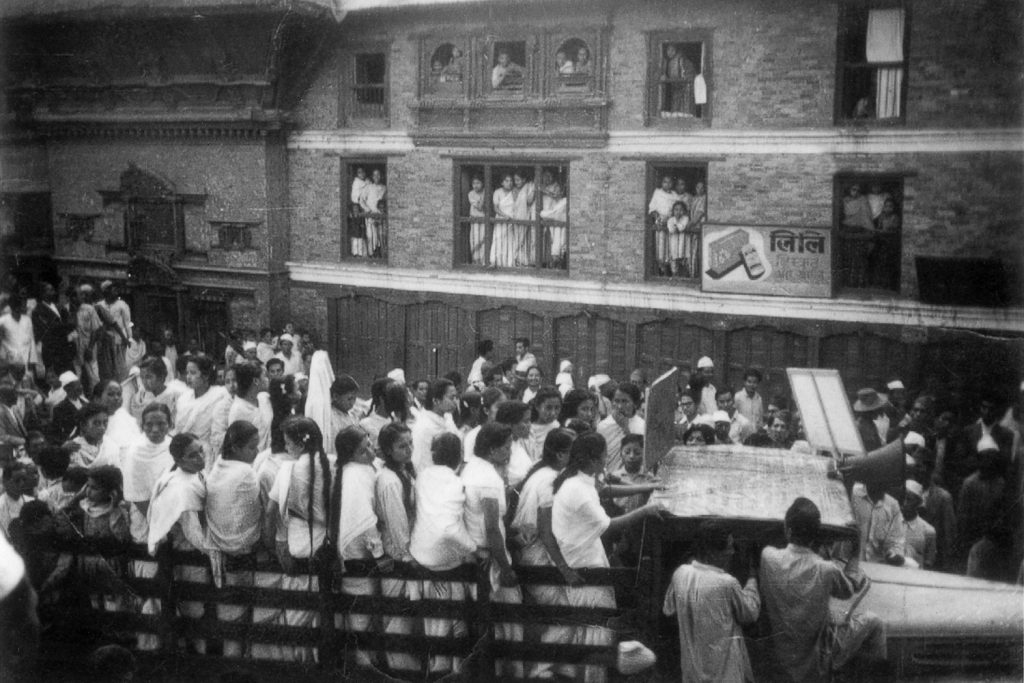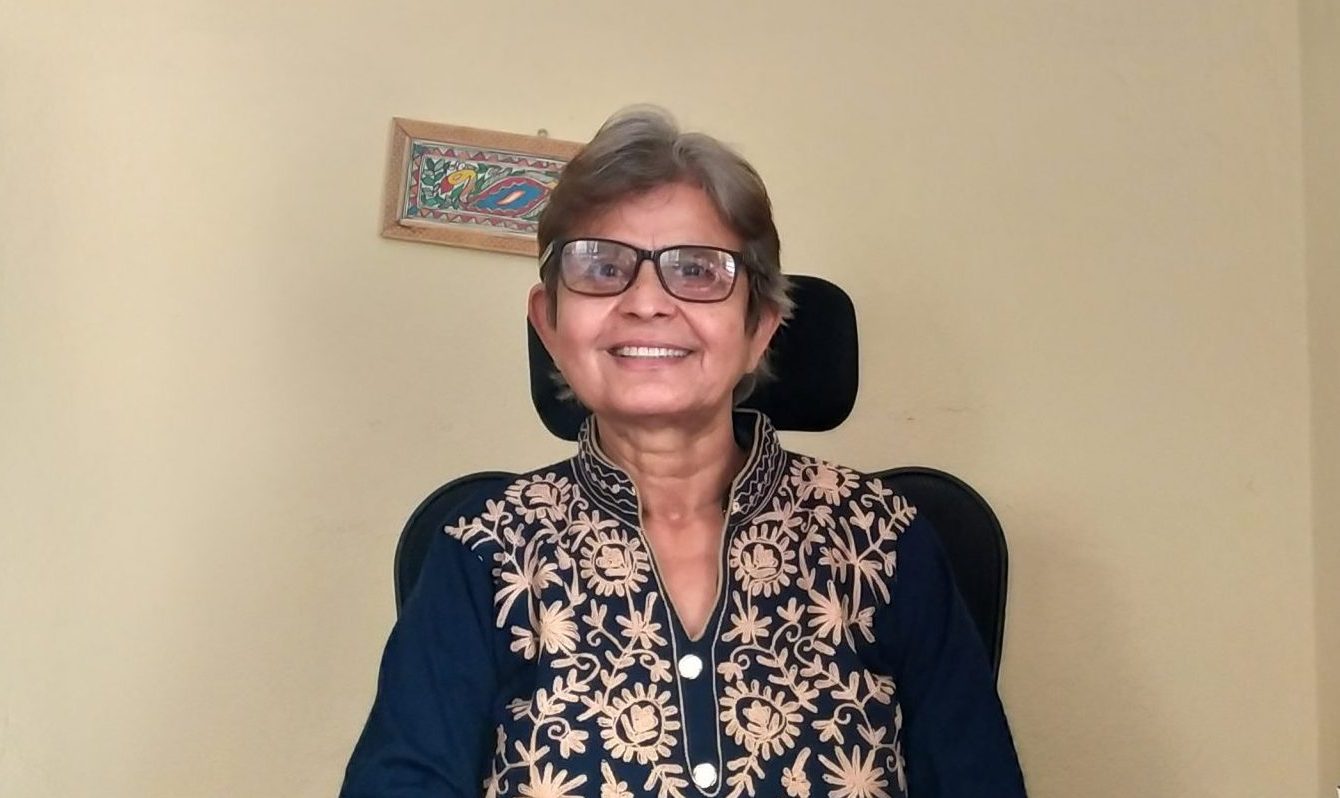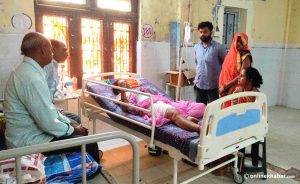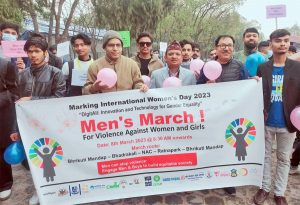Last month, when the Department of Immigration introduced a proposal, which would restrict women under 40 from travelling to Africa and the Middle East for the first time by requiring family’s permission and ward office’ approval, activists protested against the proposals outside the department. Subsequently, a protest rally (women’s march) against the proposal as well as for demanding an end to violence against women and impunity was organised. First initiated by Yogmaya Neupane against the oppressive rules of the Rana regime imposed on women about a century ago, the women’s rights movement in Nepal has just reached this stage today.
However, Renu Adhikari, a veteran women’s rights activist in Nepal, thinks the movement also has taken a big leap over these years. But, referring to several challenges, she says, “There still has not been a fundamental shift on the status of women in Nepal.” In a conversation with Onlinekhabar on the occasion of Women’s Day, Adhikari talked about the achievements, challenges, and opportunities of women’s movements in Nepal.
Excerpts:
You have devoted almost three decades of your life to the rights of women in Nepal. What achievements do you see these women’s rights movements have achieved till today? Are you satisfied with these achievements?
It has been around 100 years of the women’s rights movement. Coming to this point, if we look phase-wise, the women’s rights movement seems to have made great strides. However, it is painful to see that there has been no difference in the roots of these problems.
At the time of Yogmaya only, she had strongly raised the issues of widow marriage (now, we associate this with the right to body, sexuality), caste discrimination, and violence against women. She had symbolically brought up the root cause of all these issues, or power relations, back then.
Likewise, during the time of Divya Koriala as well, voices against violence against women (VAW), the dowry system, the ghumto system were raised. It was only after the formation of the Nepal Women’s Association in the last 1940s that the issue of women enfranchisement was raised.
After the 1951 democratic movement, the All Nepal Women’s Association was formed by Marxist women. They spoke up for labour rights (equal pay). Also, activists like Chanchala Devi fought for the right to education and also started a school in Banepa. Gradually, in the 1959 elections, Sadhana Pradhan became the first elected woman’s representative at the municipality level.

Then, the women’s movement took a different appearance in the early 1960s. Political parties become underground. King Mahendra came into power. And, he suppressed those voices raised in the movements by establishing Nepal Mahila Sangathan of royalist women.
The Panchayat system also brought different programmes for women. Although it is said that such programmes have made significant contributions to the women’s rights movement in Nepal, politically women were suppressed. Meanwhile, donors launched welfare-driven programmes considering the political condition of Nepal.
After the re-establishment of democracy in 1990, two major changes took place: women’s participation in politics was more visible, and international organisations began working on women’s rights in Nepal.
During the civil war, the role of women gradually began to change as the Maoists’ movement raised the issues of identity, participation, and right to lineage. Also, the women were included in the Maiosts’ army. The attitude of people towards the image of women began changing since then.
But, just before the 2006 people movement, WOREC (the organisation that Adhikari founded and led for several years) organised women’s conferences in all five development regions of the country. We found that many women were sexually abused, displaced, and some became widows during the war. But, they could not speak up about their sufferings only at that time.
Also, after the reinstatement of the House of Representatives in 2006, laws were made to ensure that various political mechanisms include women at least 33 per cent of their positions. This step initiated a new wave in the women’s movement of Nepal. But, when the committee for drafting the interim constitution was formed, there was no woman. After pressure from various women’s rights activists and organisations, women were included in that committee.
In recent years, the dominant issues in the women’s movement have become gender-based violence and women’s participation. As a result, the 2015 constitution included the major rights of women. We also saw women’s increased participation in politics as around 40 per cent of local government officials are women now. Strict laws regarding gender-based violence, reproductive rights, and the rights to quality, education, health, and employment have been formulated.
Analysing the current situation, do you find Nepal as a progressive or regressive country for women?
No doubt, Nepal is a progressive country for women. But, what pinches us is that in the current political conflict, the kind of slogans used, statements made, how women have been addressed at every level from the president to the public have given a negative message. This has hindered the transformation that has just begun.
In my perspective, the negative statements of the opinion-makers have pushed the women 10 years back.
What kinds of negative statements have taken women 10 years back?
If you listen to the statements made by political leaders like Raghuji Pant (about Komal Oli), Ram Bahadur Thapa (that rape is not a new phenomenon), Ram Narayan Bidari (that women resort to complaining about a rape case after they do not find a relationship enjoyable), it will be clear that such mentality is still prevalent in our society and their impacts are also seen in the society.

Besides that, what other weaknesses do you find in these movements? Have these movements highlighted some issues more and left behind some crucial issues of women?
Every movement has weaknesses. The major weakness I see in the women’s rights movement in Nepal is that there has been a lack of political analysis of women’s rights issues. Most of the things moved forward in the welfare approach.
And, the next weakness I see is that women’s associations affiliated with political parties are not strong enough.
If we see the women’s rights movement of the entire world, we can see that their primary focus is political participation, meaning there should be the participation of women at the decision-making level. Secondly, they were focused on improving the status of women as they were considered second-class citizens.
It may seem that it has been a long time since the women’s movements have started here. However, if we look in essence, we can find that the actual movements began after the 1990 revolution. The reason is that without democracy, women’s rights cannot be guaranteed in any other political system.
As of now, what are the major hurdles in the way of assuring women’s rights in Nepal?
There still has not been a fundamental shift on the status of women in Nepal because there still lies the question of identity (citizenship) in the constitution.
Likewise, women’s leadership has not been accepted. Impunity: there still has not been an environment of getting justice after gender-based violence. The perspective of looking at women’s bodies has not still changed. Sexual violence at the time of civil war is not still addressed.
I already talked about mysoginistic statements made by our politicians.

So, who should do what for creating an equal society?
Patriarchy controls three major things. The first is productivity. Patriarchy controls the productivity of women as women’s work has not been recognised as ‘work’ and has not been valued.
It is very crucial to value the home-based labour of women by making labour desks at every local level and registering their works and including them under the boundary of social security. Likewise, the reproductive role of women should be respected. Child care centres should be increased from the community level.
Second is the control over the body of women (sexuality, wearing whatever we like). I feel the government needs to bring systematic programmes to end that control and also bring awareness to the public.
The third thing that patriarchy controls is the mobility of women. We need to bring freedom from these controls. For this, first and foremost, the government has to bring gender equality policies and programmes in order to localise or implement the laws and rights guaranteed by the constitutions. Also, the government should run mass social transformation campaigns jointly with activists, media, local leaders and all.
The deep-rooted definition of masculinity and femininity in society should be refined or changed.
When do you hope to see an equal society in Nepal?
If we could work together as I have mentioned earlier, I do not see the transformation away. We are in a positive place.



























